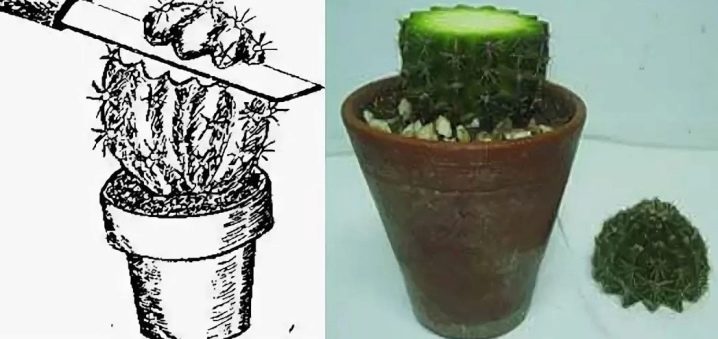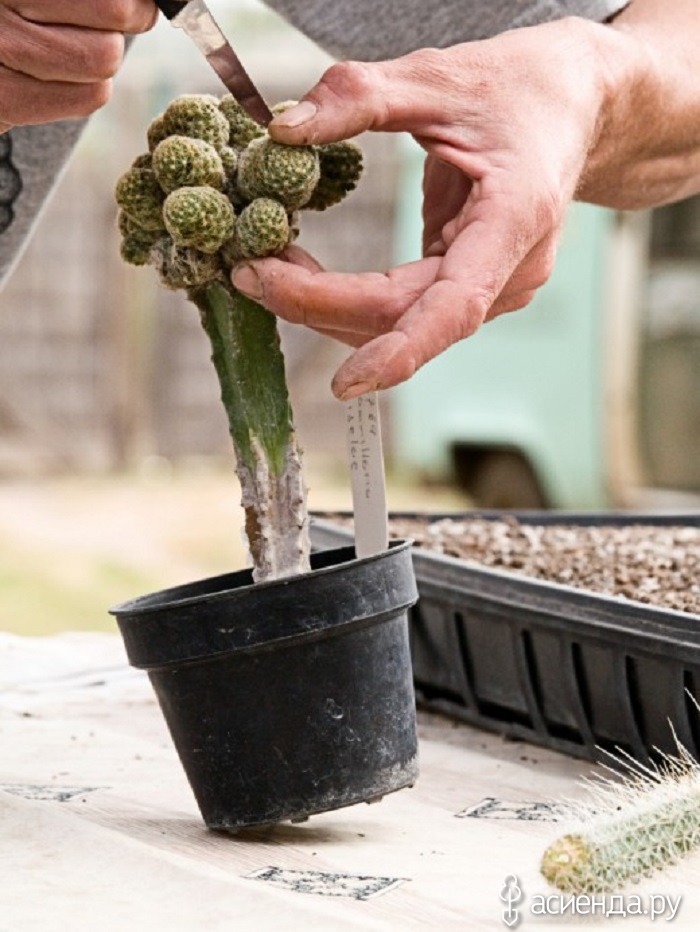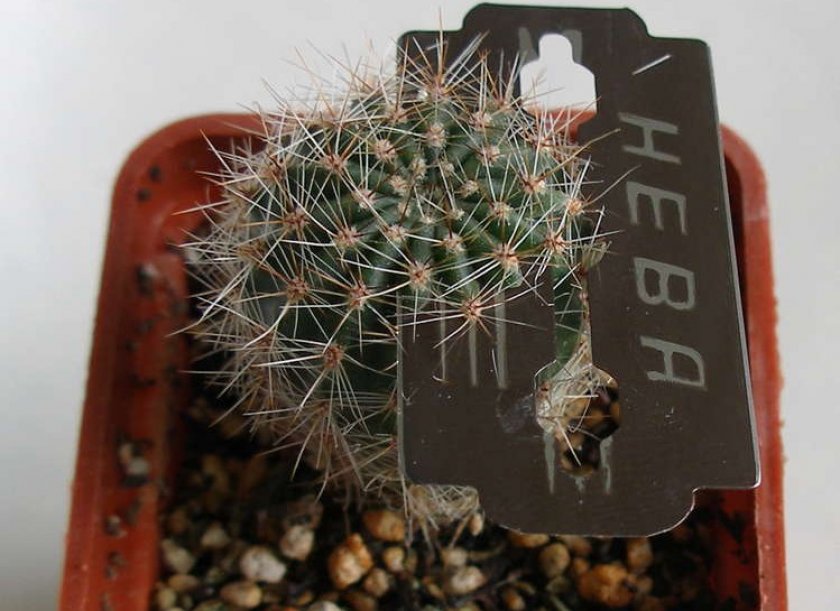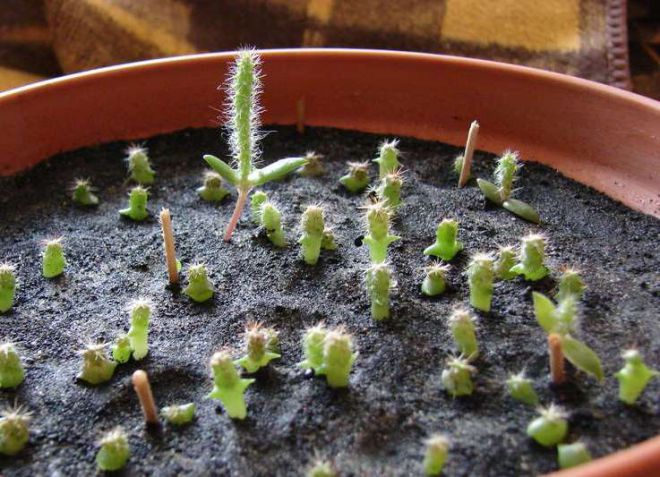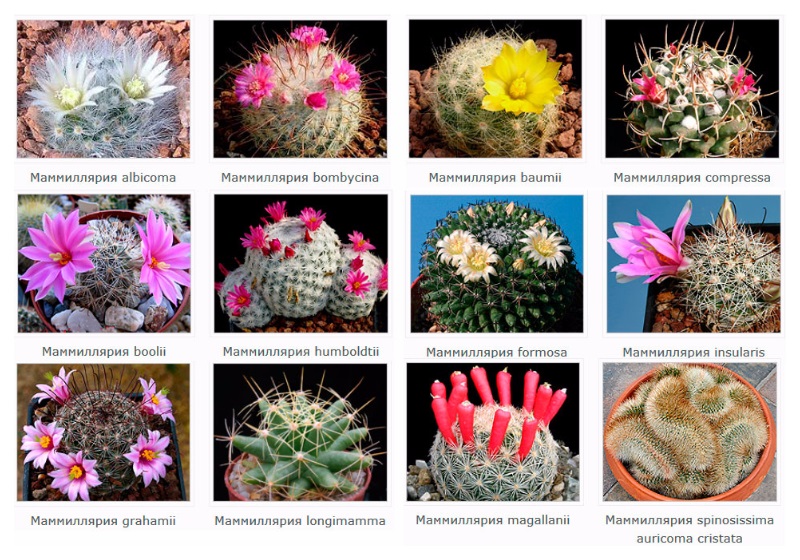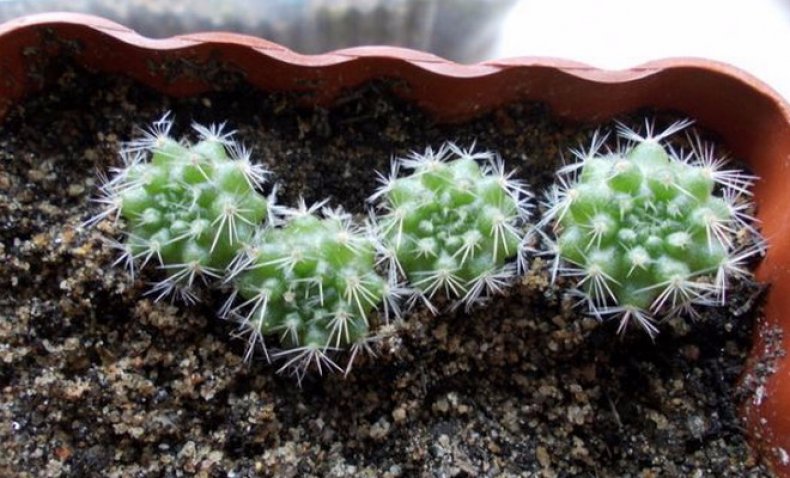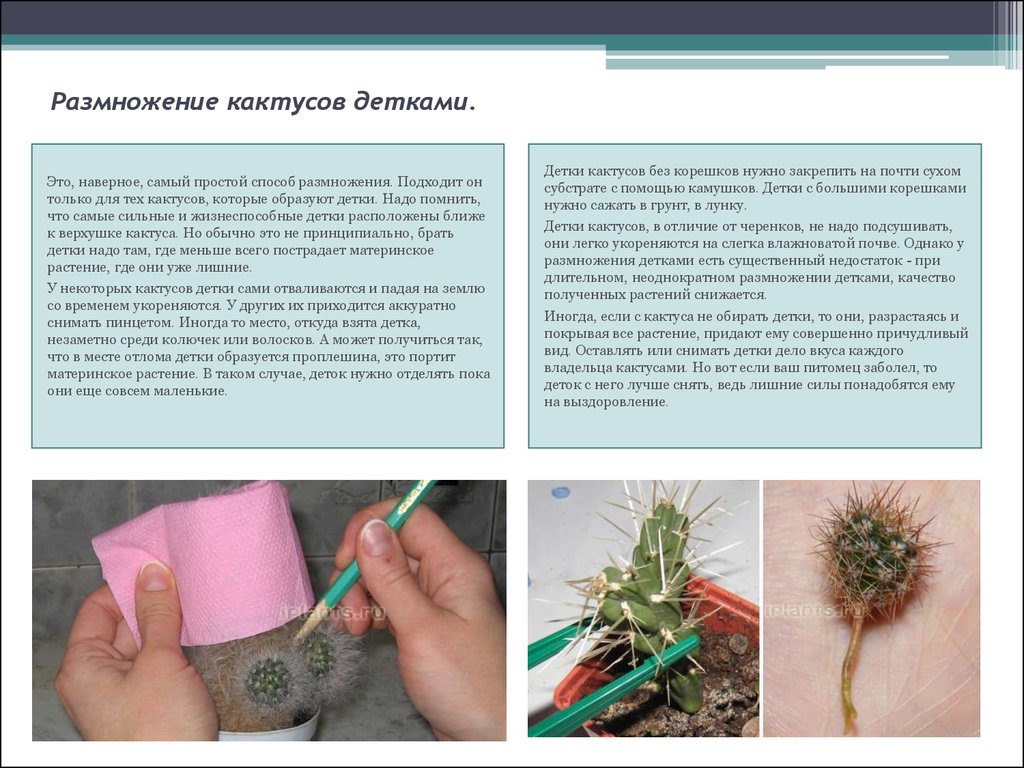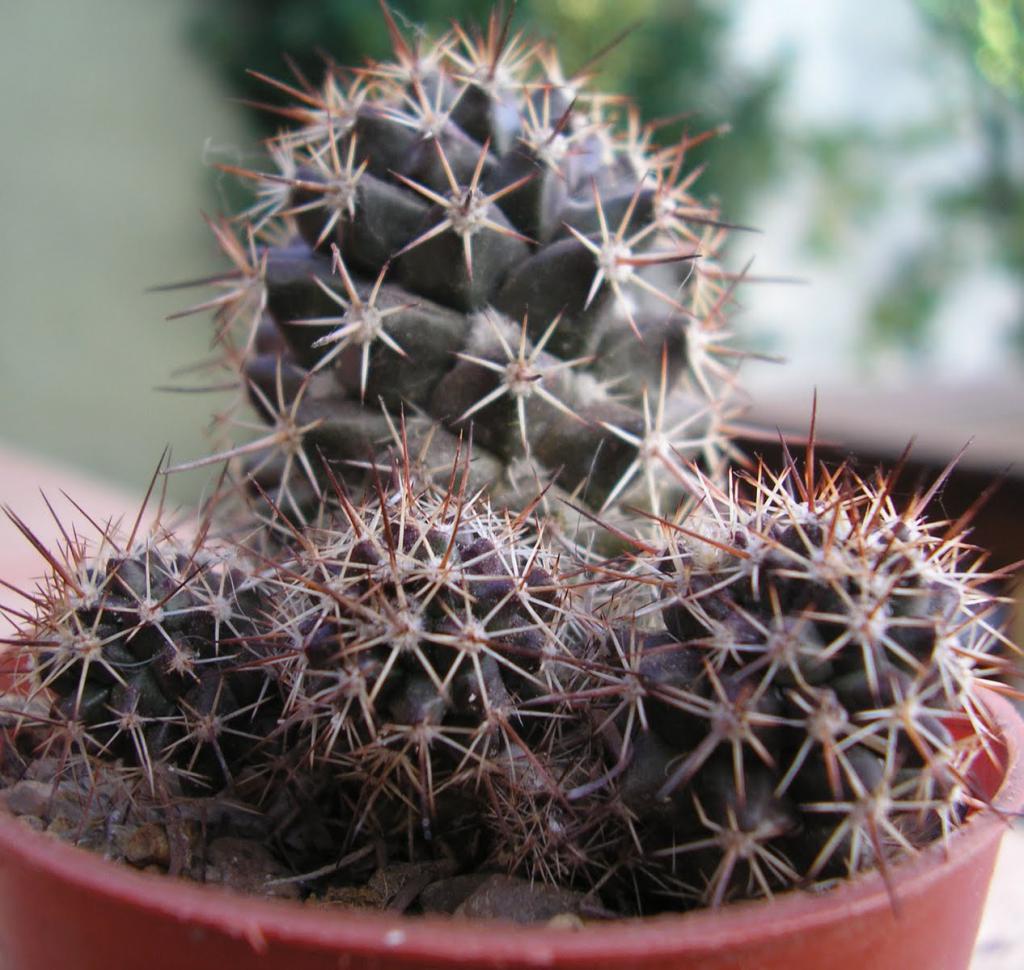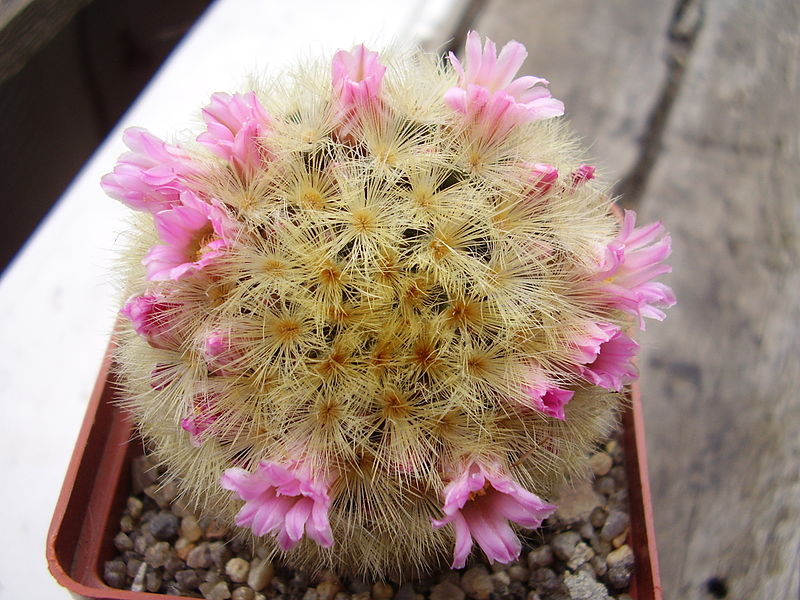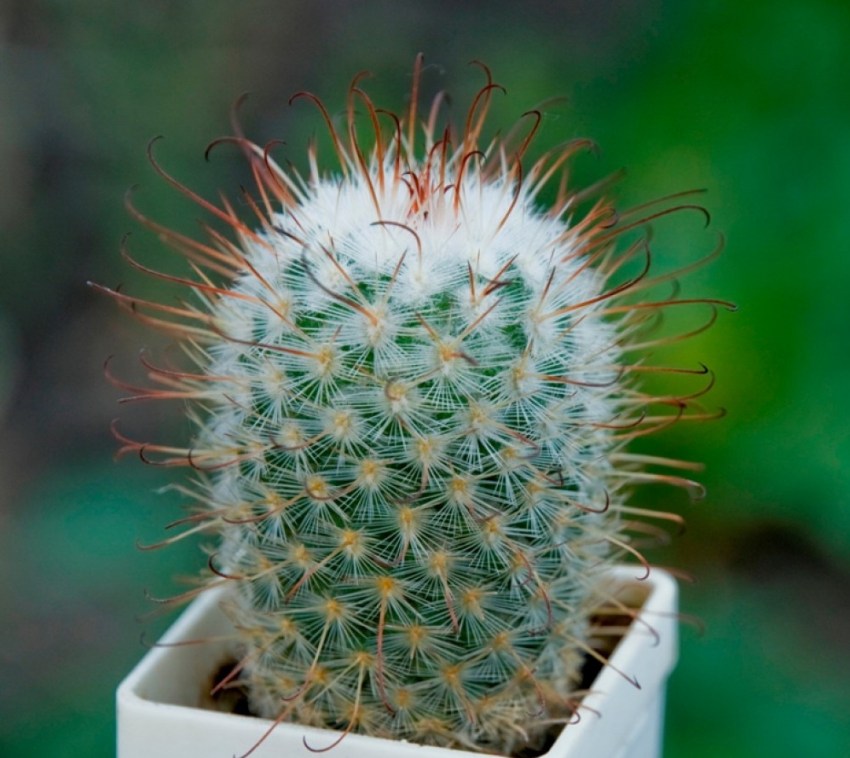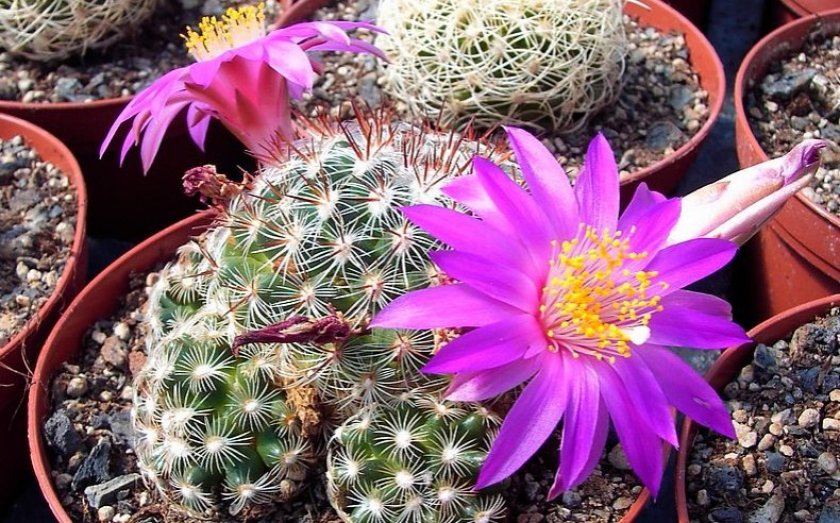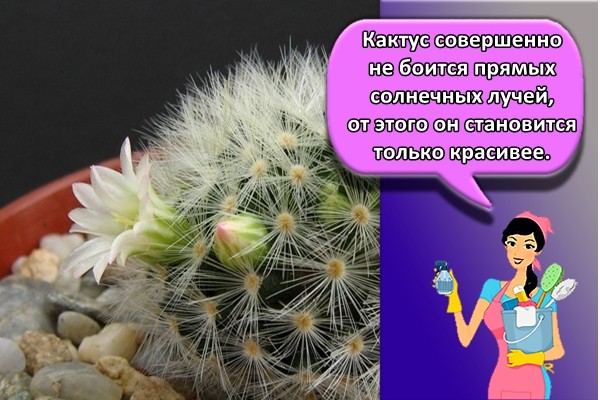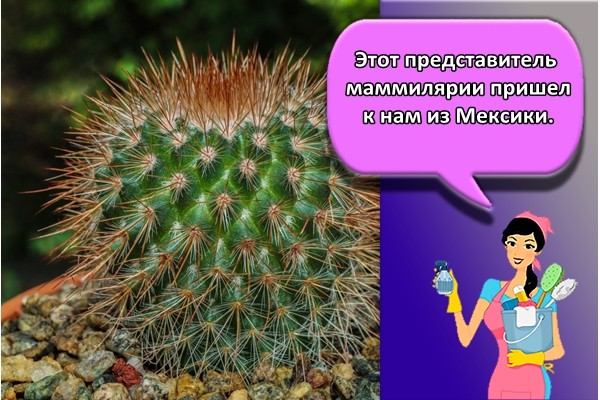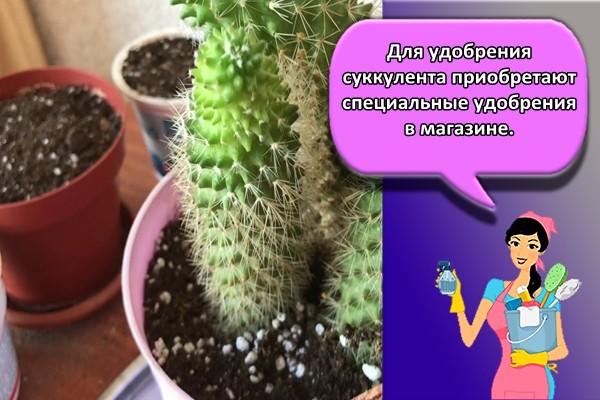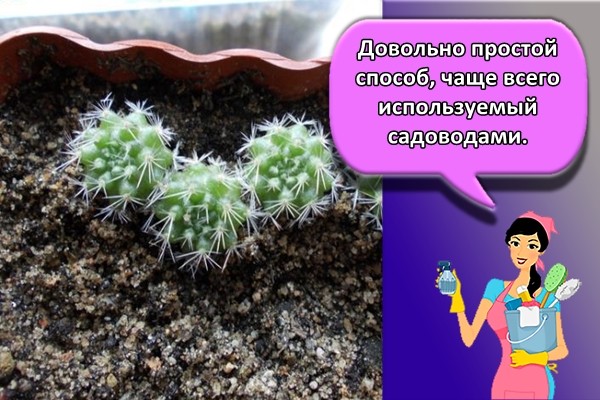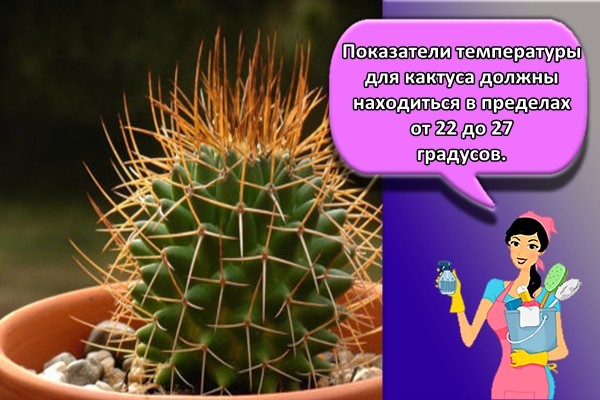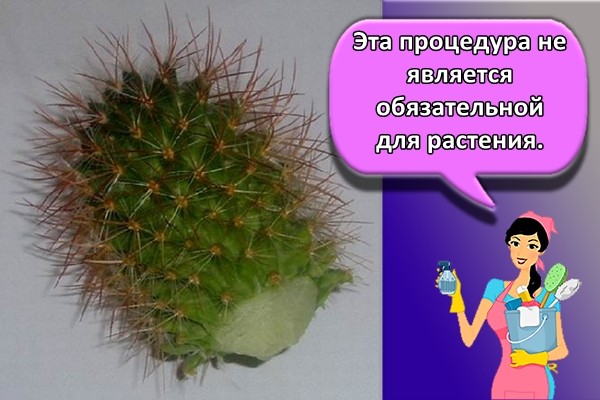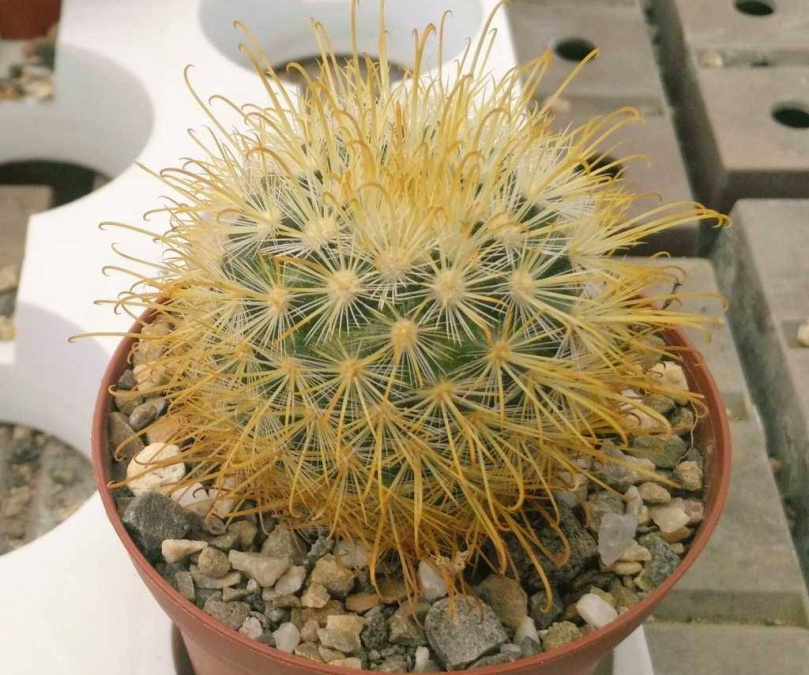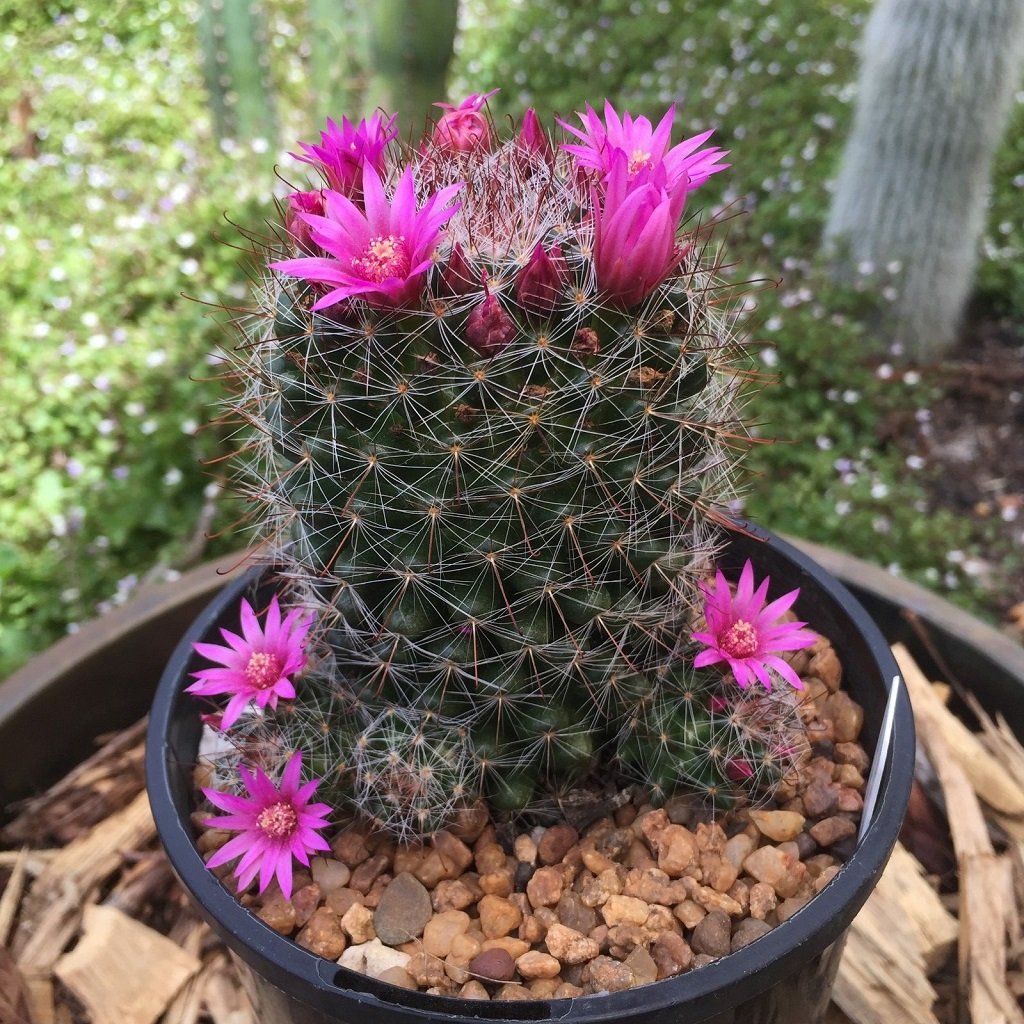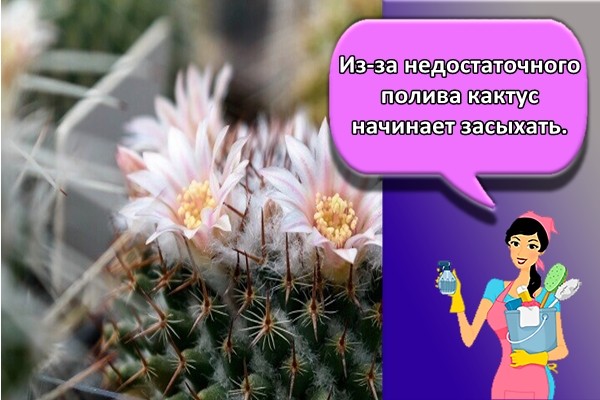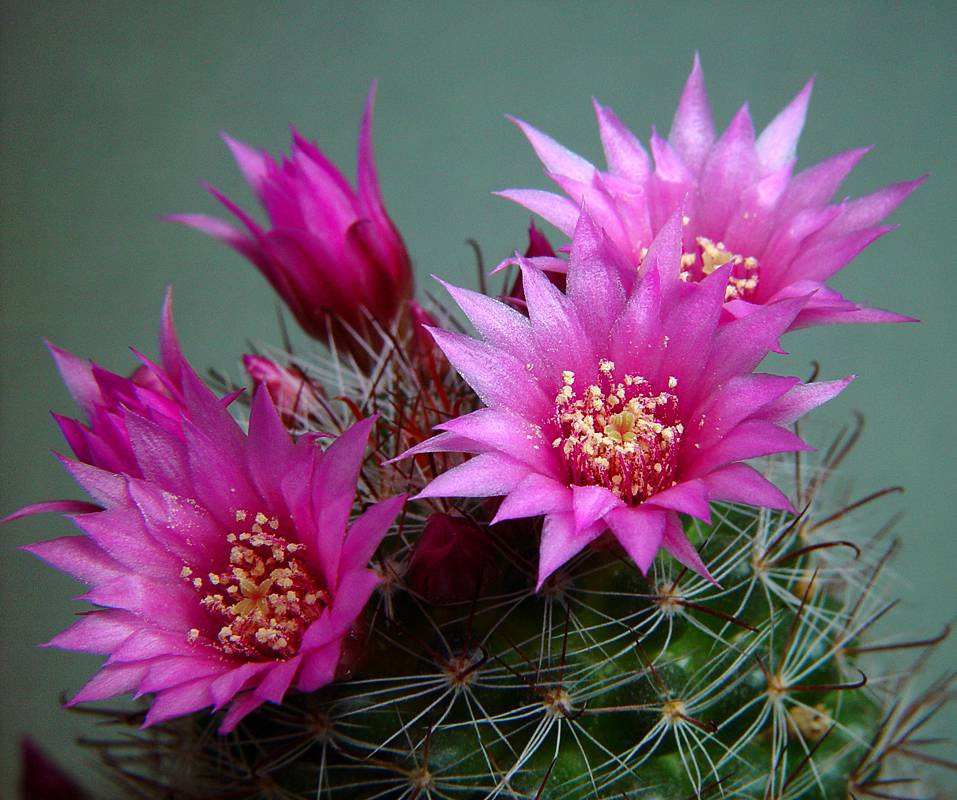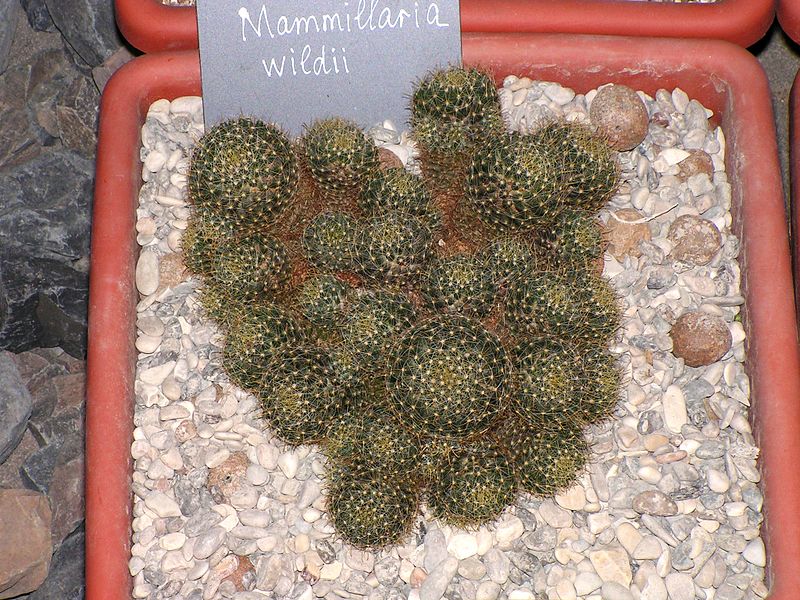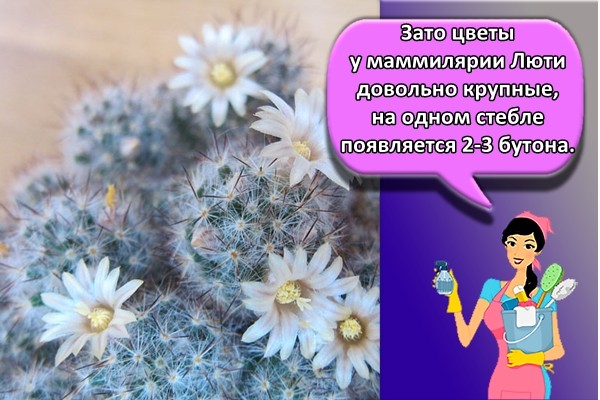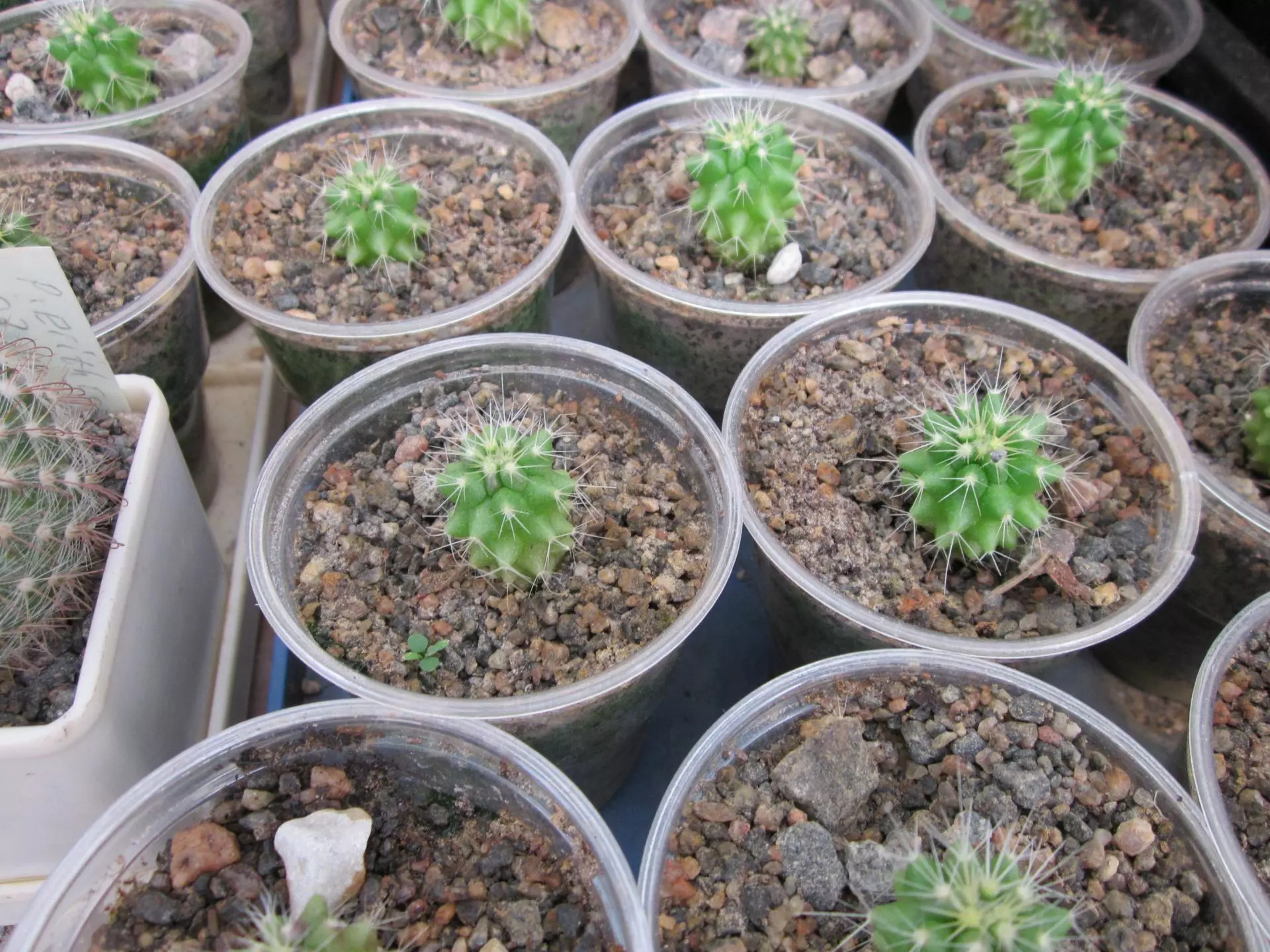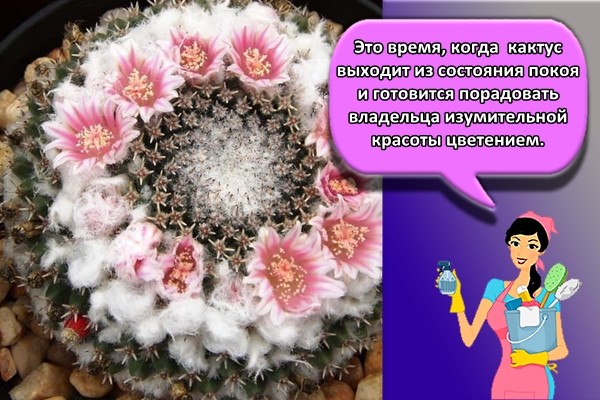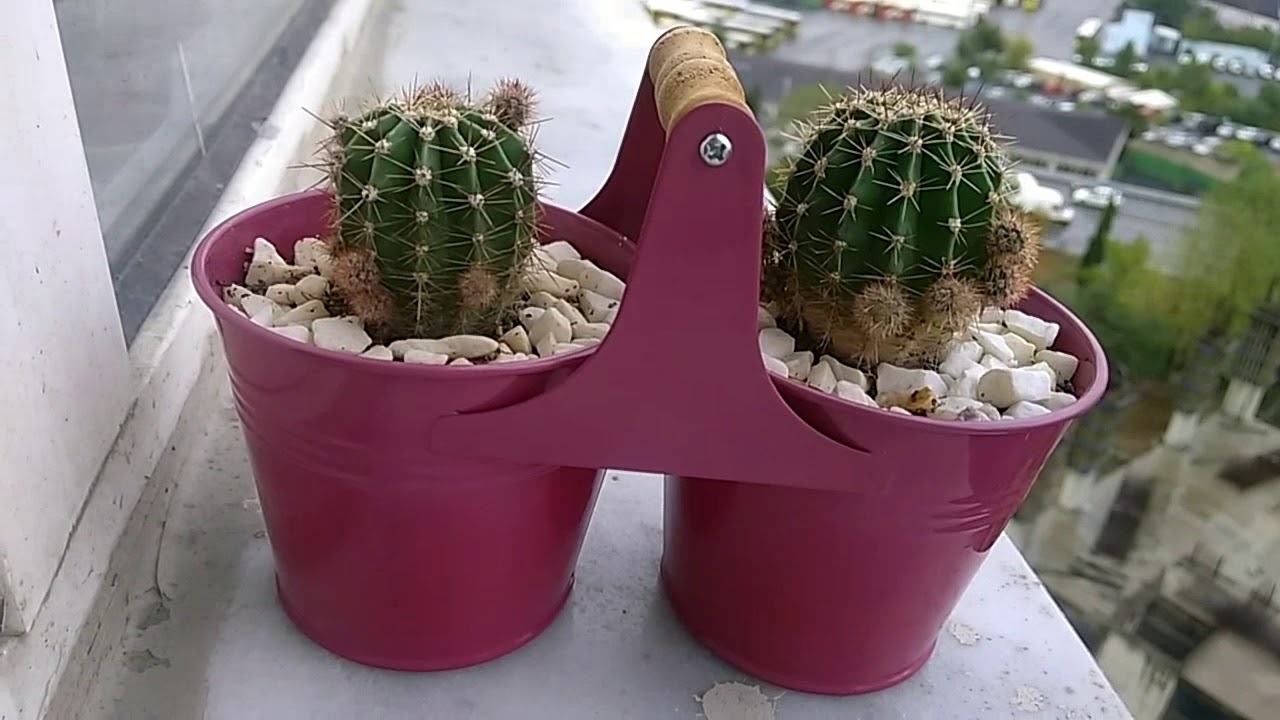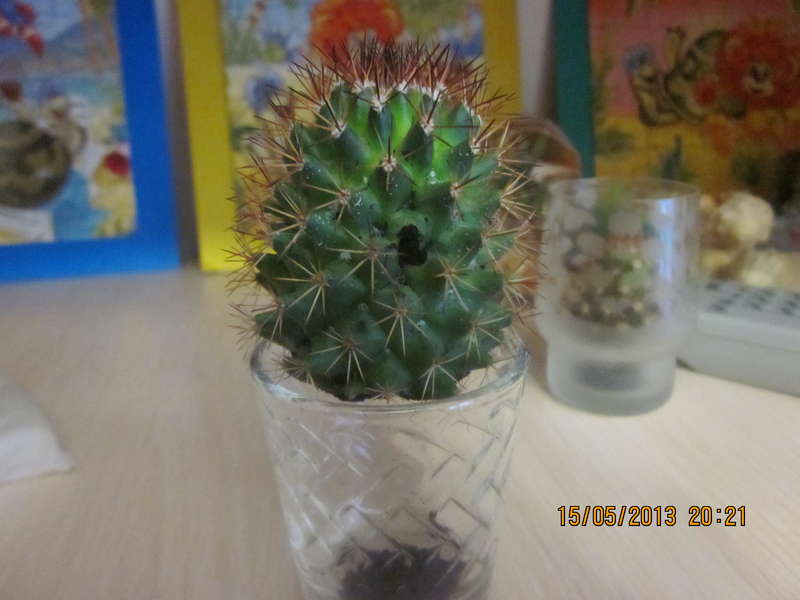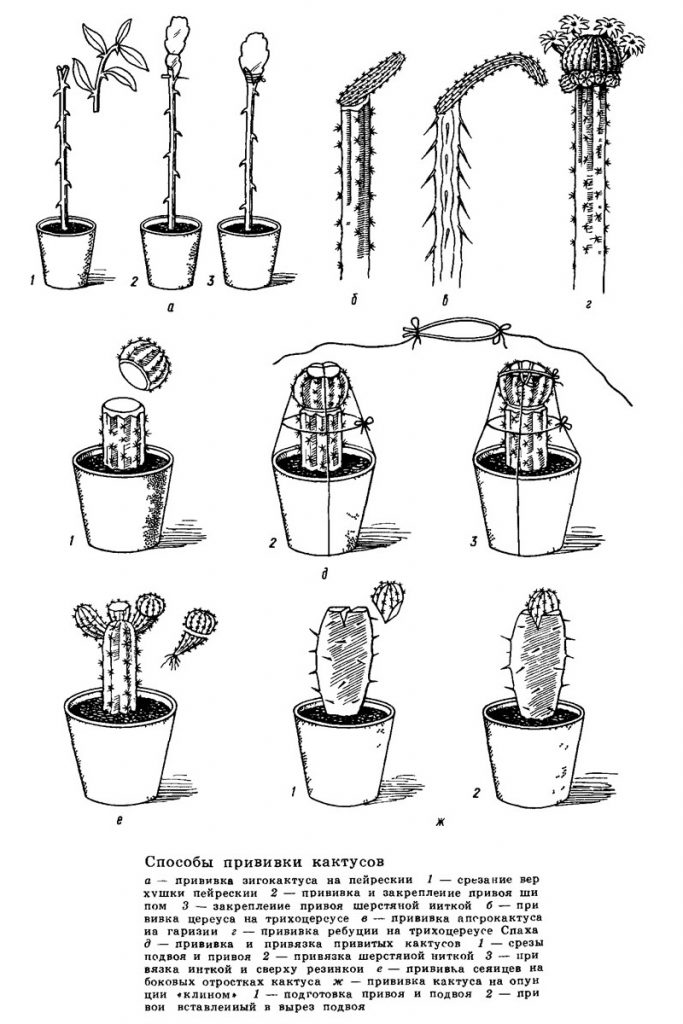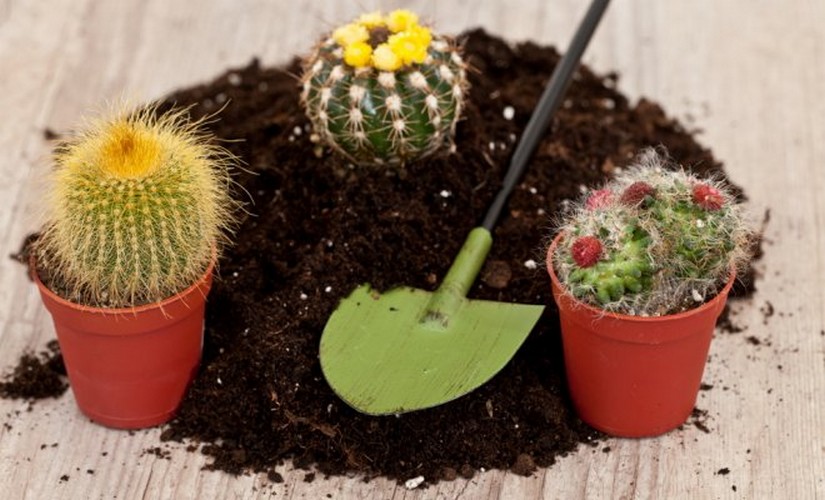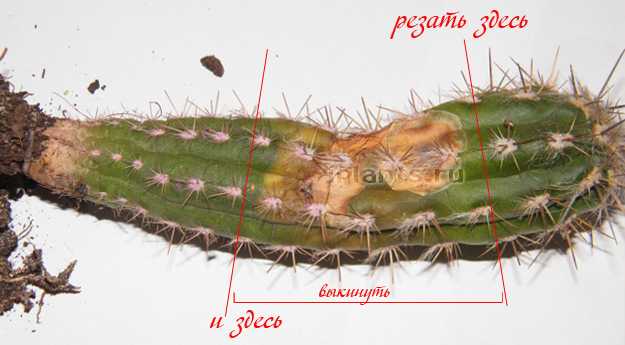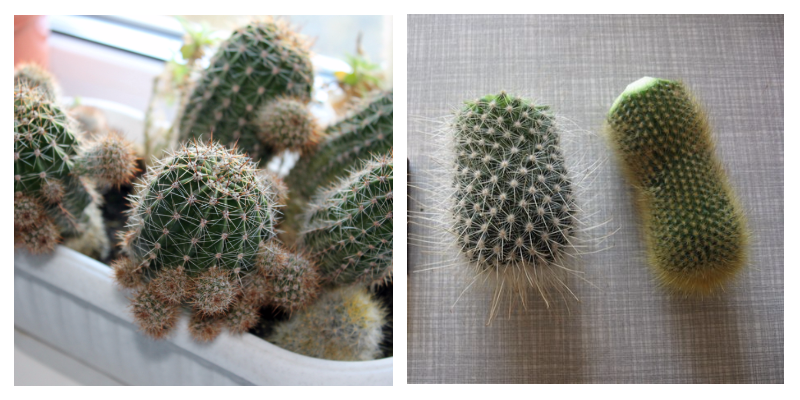Home care
Temperature regime
Even in the hottest weather, Mammillaria mix feel great. In winter, it is recommended to give the plants a rest, placing them in a cool place with a temperature of no more than 10-15 degrees. There are varieties that are resistant to frost up to -7 degrees.
Watering
It is necessary to water the Mammillaria mix quite rarely, in small portions of water. The earth should dry out completely. In summer, it is enough to water 2 or 3 times a month, in winter, once a month, wetting only the top layer of the earth. If the indoor air is dry, you can spray it occasionally.
Lighting
This species of cactus is very fond of bright lighting. But it should be borne in mind that if the windows face the south side, at noon you still need a little darkening or ventilation.
Important! During the flowering period, which may even be in winter, it is important to provide 16 hours of daylight hours; this will require artificial light.
Soil composition
The composition of the soil should be as follows: in the proportions of 2: 1: 1, coarse sand, leaf and sod land are mixed.
In order to avoid stagnation of water, small brick chips are added in the ratio of one teaspoon to one glass of earth.
And to prevent root rotting, crushed charcoal is used in the proportion of one teaspoon per glass of soil.
If you buy ready-made land for cacti, it is recommended to buy more river sand and mix.
Pruning
Trimming Mammillaria mix is needed only for deformation. The main task of this procedure is to give shape to an overgrown plant. Let's consider in stages:
- To sanitize hands and tools.
- Cut off the desired part of the plant. The cut site is processed with crushed charcoal or pharmacy charcoal.
- We send the mammillaria mix for a couple of days before the slices dry out in a dry, dark place.
- Subject to further planting of the cut material, it is necessary to fix it in a glass of water so that the distance from the surface of the liquid is 5 mm. After the appearance of the roots, landing is carried out.
Top dressing
You need to feed cacti about once a month with special additives, especially during the period of active growth (spring, autumn).
Attention! No feeding is required in winter.
What capacity is needed for planting?
To plant a mix of mammillaria, it is necessary to pick up a low and wide pot made of plastic, ceramics, darkened glass. Metal pots are not recommended. A drainage hole at the bottom is required. In terms of volume, the pot should be slightly larger than the total volume of the root system of all plants in the mix.
When can you transplant?
Mammillaria mix is transplanted in the spring time every 2-3 years.
- Before replanting the plants, it is necessary to water the earthen lump and carefully remove the roots.
- Next, the roots are washed, separated and seated in different pots.
- The flower container should be wide, flat and with large drainage holes.
Wintering
For winter, the mix is prepared in the fall, reducing feeding, watering and reducing the temperature regime. If these are pubescent cacti, then the temperature should be at least +15 degrees. For the rest, + 7-10 degrees is enough. Watering is not required in winter. If the plants are stretched, this indicates that they are not sleeping, and a fluorescent lamp is required to illuminate them.
Similar plants
- Fellosperm. The plant resembles mammillaria, but differs in larger flowers of almost all shades of red and a special structure of seeds.
- Rebucia is a medium-sized cactus, spherical stems, up to 5 cm in diameter, with a depression at the top.
- Bauma.Small yellow flowers. The cactus is found in the province of Tamaulipas.
- Zeilman. A plant with a cylindrical stem and a large number of curved spines. It blooms in spring with pink or white flowers.
- Bokasana. The stem is green-blue with dense white pubescence. Elongated red fruits.
Each of the species diversity of the houseplant Mammillaria is unique. Check out these types of this exotic and unpretentious cactus: Wilda, gracilis and elongated mammillaria.
Mammillaria prolifera is an ideal plant for those who want to grow flowers in their own homes, but do not have enough time to care for indoor pets.
Botanical description
Mammillaria bocasana is a cactus with a round and elongated trunk. The diameter of the stem can reach 5 cm. The height of adult cacti is 8-10 cm. At the base, the rhizome branches into several trunks, forming a colony.
Thin and brown spines with a curved tip, 8 to 10 mm long, are located on a dark green trunk, covered with silvery hair. The needles on the tubercles are yellowish.
Mammillaria bokasana blooms in spring, with small flowers in shades of white and light yellow on the top of the stem. The base of the flower is hidden among the tubercles with spines and only the petal part remains visible on the surface. Petals up to 1 cm long are pointed at the ends. If the cactus has been pollinated, then elongated fruits, painted in pink-red shades, will appear on it.
A feature of the species is that the various subspecies and varieties are very different from each other in appearance. Some have weak and thin thorns or, conversely, very long and strong. The tones in which the flowers are colored can vary from cream to deep pink (cultivar rosea).
One of the forms of Mammillaria bokasana, a monstrously growing plant, is unusual. Instances of this type do not look like ordinary mammillaria, they are almost devoid of thorns, have a light green color and are covered with growths uncharacteristic of the species.
What you need to know about watering cacti
The amount of water and the frequency of watering that are recommended for the normal functioning of the plant depend on many factors, for example:
- the type and size of the cactus;
- its age: young plants need more frequent watering, and adult and venerable cacti need to be watered much less, since they have sufficient water reserves;
- seasons;
- air humidity, illumination and ambient temperature.

For cacti, it is important to create a home model of a desert or rainforest on the window. Therefore, you should remember the main rule for watering cacti - you rarely need to moisten the soil, but quite abundantly.


In cold and rainy times, watering cacti is recommended to be minimized. During active growth, which can be seen by the green crown and the appearance of new needles, it is necessary to spray the plant daily. Cactus lovers note that in spring and autumn, cacti should be watered in the morning, and in hot summer - in the evenings.

Reproduction
Mammillaria reproduce well with the help of young shoots (children). But with long-term cultivation from children, plant degeneration is observed, therefore, in order to preserve the variety, breeders periodically grow cacti thanks to seeds.
If propagation is carried out by shoots, then they are cut off at the base and left in the air for a week. This is necessary to dry out the cut site. Then the cut shoot is planted in wet sand and watered a little.
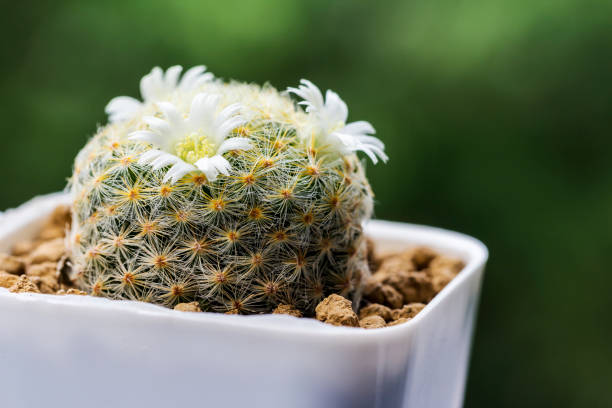
When choosing seed reproduction, they must be soaked in a weak solution of potassium permanganate. Then they must be planted in a shallow pot filled with wet sand, covered with a film or placed in a special greenhouse. Seed germination is carried out at 22-25 degrees.When shoots appear, the film is removed, and with the formation of the first spines, young plants are seated in separate containers.
A variety of plants can be grown at home. Mammillaria are an excellent example for learning the peculiarities of growing and breeding thorny pets.
Description of the plant
The flower is a small spiny ball or cylinder. Its body is covered with pimples (developed leaf papillae).
Above them is a spiny or hairy areola - a sinus. In it, over time, shoots and flowers begin to grow. They are located at the top, forming a wreath.
The size is small.

In the second year, berries begin to form.
The Mammillaria cactus stands out clearly from other plants in the family. The numerous papillae are the main distinguishing feature. It is from their tops that needles come out. And flower buds grow from the depressions between the pimples.
Such formations are characteristic of all varieties of a flower. Many are decorative. Their breeding is practiced in apartments and greenhouses.
Plant species
Let's consider the main types of mammillaria.
Elongated mammillaria
A plant with an elongated thin stem. The tubercles are small, contain gold-colored thorns that begin to grow from a common rosette. It blooms with white small buds and only in good conditions. Pollination is necessary for the formation of fruits. Growing at home is possible.
Wilda Mammillaria
It has a thick and long stem up to five centimeters in diameter. Long yellowish spines emerge from thin pimples. The main one in the center is crocheted. In the sinuses, sprouts often appear that do not fall off on their own. Therefore, the plant branches strongly. It blooms in small light flowers. Pollination is also required for the berries to appear.

Prickly mammillaria
This species is characterized by a spherical and stem covered with long thin light spines. Through the needles, you can see a light fluff, similar to balls of cotton wool. It blooms in bright pink buds.
Mammillaria Zeilman
The flower is characterized by a short, cylindrical stem. The spines are densely arranged and curved. It blooms with buds of pink or white shades.

Bokasan Mammillaria
Variety with thickened stems about 5 cm in diameter. The papillae are elongated, have many shoots on themselves. The spines are unusual. The central one is the longest and is crocheted. Some are thin, in the form of needles. Others are hairy, giving the impression of fluff. This type of mammillaria is unpretentious in indoor conditions. Forms white flowers on itself. Over time, there are a lot of them.
Mammillaria Ghana
The stem of this variety is spherical or cylindrical. It is quite thick and reaches ten centimeters in diameter. The flower is fluffy due to the large number of white hairs. It blooms with bright pink buds, which are beautifully arranged in the form of a wreath on the "crown" of the plant.

Escaping mammillaria
The stem of this species is small and thin. It branches quickly and easily, thanks to the large number of children. The spines are thin, hair-like, but sharp. Very tightly spaced. Because of them, sometimes the stem of the mammillaria is not even visible. Flowering is easy and active. White buds quickly form, in place of which berries appear over time without pollination.
Varieties of cactus
Previously, about 500 plants were counted as this species, today the classification has been revised, significantly reducing the list. Only the brightest representatives of the genus now belong to the mammillaria cacti. Often culture lovers prefer to grow several representatives at once, forming a kind of mix at home. Plants acquire a special decorative effect during the flowering period. In most varieties, it lasts only 1 day, it can only be observed at night. The appearance of the inflorescences varies greatly.The trunk can be covered with small flowers or have only 1-3 large bright buds.
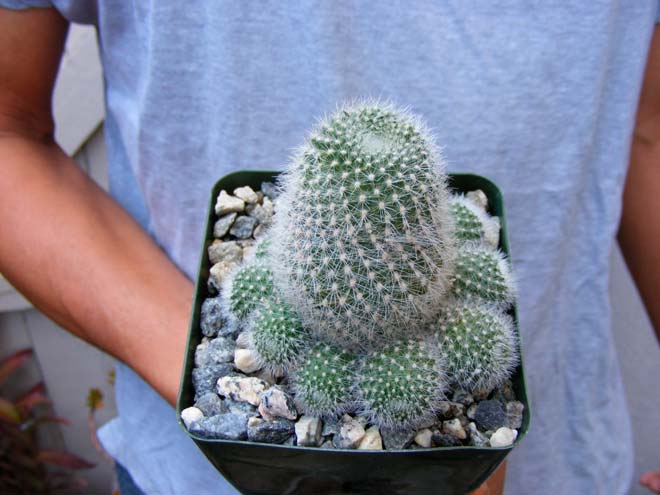
Some types of mammillaria:
- albicoma;
- baumii;
- bombycina;
- carmenae;
- deherdtiana;
- elongate;
- formosa;
- grusonii;
- humboldtii;
- lenta;
- mystax;
- nivosa;
- saboae.
Whiskered
Mammillaria mystax is a globular or oblong cactus of dark green color with a gray bloom, tends to bush. The apices of the 4-6-sided papillae and axillae are covered with matted white hairs. There are 3-4 central spines. Their length is 2 cm, while the most curved needle can reach 5 cm.Wavy, whitish spines with brown tips can be 5-10 pcs., Their length is up to 0.8 cm.
The flowers of the mustachioed mammillaria are red with a pink tint, arranged in a wreath on the crown. Berry-like bright fruits 1-3 cm long ripen in the second year. Seeds are small, can be red or brown in color.
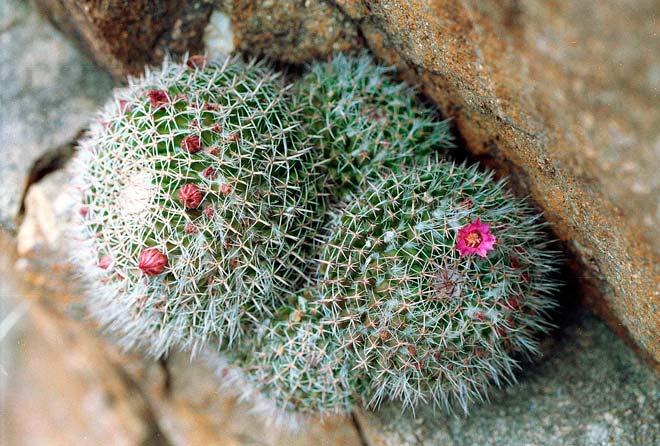
Elongated
One of the unusual representatives of this genus cacti, has become popular in modern indoor floriculture, has more than 10 varieties. Mammillaria elongated or mammillaria elongate forms a branching stem with a long cylinder shape up to 15 cm, on a cut up to 3 cm. 25 pcs. Flowers appear around the crown of the cactus, are 1.5 cm long, poor yellow in color.
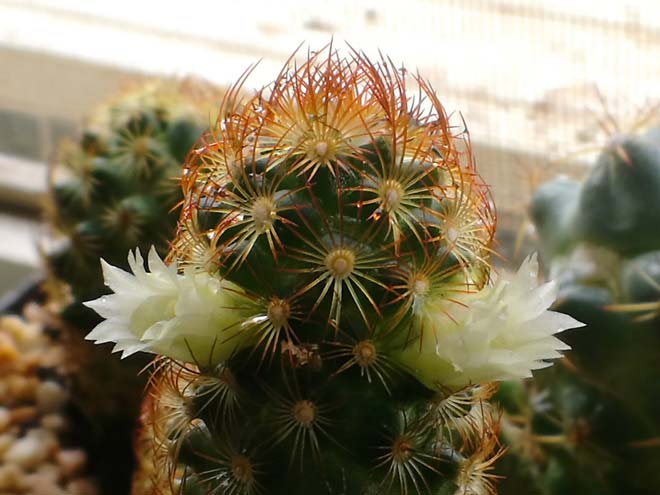
Snowy
Mammillaria nivosa forms a dark green or bronze spherical stem up to 10 cm. Initially it grows singly, later gives groups of 40 or more. Mammillaria snow develops quickly, is sensitive to low temperatures, begins to bloom at 3 years old. Radial spines can be from bright yellow to dark brown, up to 2 cm long, arranged in 6-13 pieces. At the end of summer, bright red berries ripen.
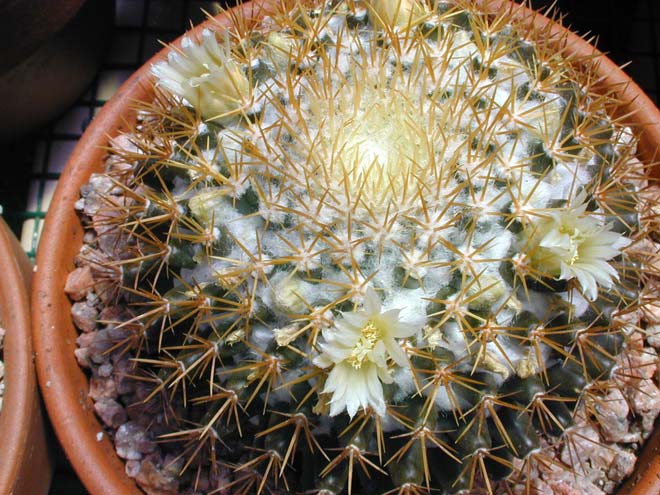
Satin
Mammillaria bombycina, in addition to its beautiful decorative appearance, is distinguished by the fact that when viewed from above, clockwise spirals are visible. Moreover, their movement is directed in the opposite direction. Tubercles are always in the 11:18 ratio, called the Fibonacci number.
Satin mammillaria has a bright green, spherical, slightly compressed stem up to 8 cm in diameter, about 20 cm high. As it grows, it forms additional branches. Central reddish-brown spines up to 1 cm long 4-8 pcs., Whitish or yellowish radial (0.5-1 cm) - up to 40 pcs. The pink funnel-shaped flower grows up to 1.5 cm in diameter.

Mammillaria cactus care
Consider how to properly care for a mammillaria cactus.
Light
The plant is very light-requiring. But almost all species do not tolerate direct sunlight. The pubescent specimens need especially good lighting.
Temperature regime
Mammillaria, the care of which also consists in maintaining the temperature regime, loves moderate indicators. During the winter, there is a dormant period. Indicators at this time should be from 7 to 10 degrees in dry conditions. Fluffy species require temperatures around 15 degrees. In summer, the plant needs fresh air. Therefore, it is best to place the flower in the garden or on the balcony at this time.
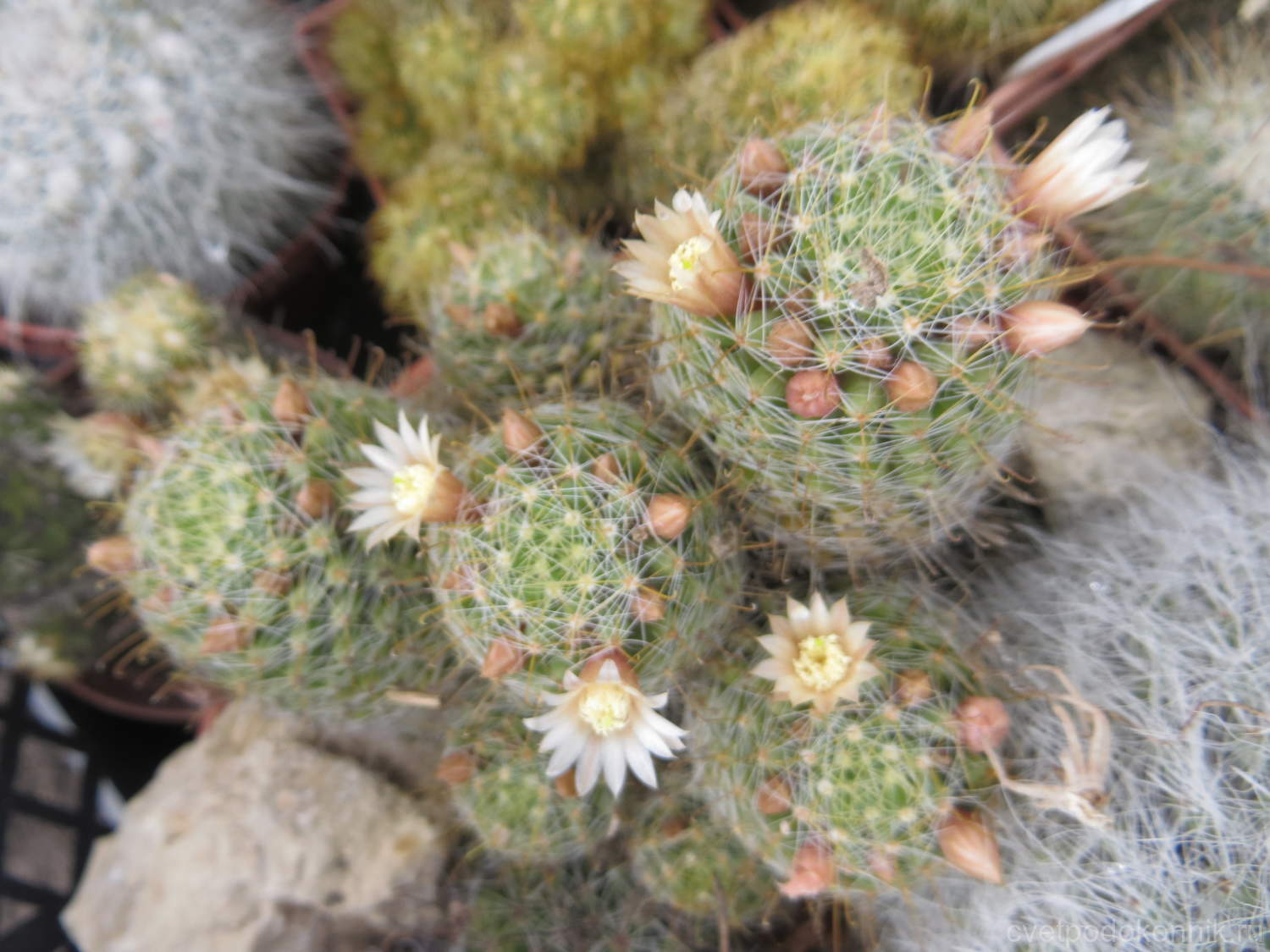
Watering mammillaria
If the plant overwinters in a cold mode, then watering is carried out no more than once a month. The abundance is regulated by the wetting of the upper earth layer. Some species do not water at all during the cold season. With the onset of spring, you need to water the plant more often. A little more water is required than for wetting only the surface part of the soil
It is important not to let it dry out. Mammillaria flower in the heat requires an increase in volume and abundance of watering
From autumn, the regime is again made more rare, preparing the plant for winter.
Air humidity
Irrigation from a very shallow sprayer is beneficial in summer. This should be done before or after the active sun. But it is believed that this cactus is not afraid of dry air.

Priming
You can create the substrate yourself.To do this, you need to mix one share of peat, leaf, turf and sand. For mature specimens, sod soil must be added in two parts.
Mammillaria at home requires wide and shallow shape pots. We need an annual transplant of the Mammillaria cactus. Then it can be performed every two years.
Reproduction of mammillaria
Most varieties of cactus easily form many baby cuttings on themselves. Over time, this can lead to the degeneration of the flower. The stems stretch out and become small, the thorns and flower buds also change their appearance.

Therefore, it is best to occasionally renew it from seed. The soil temperature for their germination should be in the range of 20-25 degrees. Such measures will help you get a beautiful and strong plant.
Pests
Mammillaria, especially the pubescent species, is often attacked by a red tick. Therefore, it will be useful to carry out prevention. The flower is rubbed with alcohol using a brush. If pests have already appeared, then 0.15% actellic solution can be used.
How to care?
For proper growth, reproduction of a cactus and its longevity, you should adhere to the recommendations for plant care:
Lighting - Wilda Mammillaria is characterized by intolerance to direct exposure to the sun. It is necessary to provide the possibility of shading, intense, but diffused lighting.
Watering - the regime depends on the season. In winter, the soil is not moistened if the air temperature in the room is 10-12 degrees. At higher rates, watering is carried out once a month. In spring, its frequency is increased; from May to the end of June, it is sufficient to moisten the soil 3-4 times a month. From August to October, watering is gradually reduced. Water is used settled, at room temperature. The volume of fluid depends on the environment. The higher the room temperature, the more water is required for irrigation.
Temperature - winter norm within 7-10 degrees, summer - 20-25 degrees
In warm weather, it is important to provide the plant with an influx of fresh air, for this it can be taken out into the garden, on the veranda, or on the balcony.
Top dressing - carried out 1 time in 14 days during intensive development (from May to early July). It is advisable to use a special fertilizer for cacti, liquid mineral mixtures
In winter, the plant is not fed.
Soil - the composition of the substrate for a young cactus includes sod land, leafy soil, peat, sand, brick chips in proportions of 1: 1: 1: 1: 0.5, respectively. For mature plants, the content of the soil is identical, but 2 parts of the sod soil are taken. Drainage is placed at the bottom of the pot.
Pot - since the plant is distinguished by branching and the formation of colonies, dishes should be chosen wide with a shallow depth.
Transfer
It is recommended to replant cacti in spring: young - annually, mature - once every 2 years.
You must first prepare the plant - do not water for 10 days for the soil to dry out.
Step-by-step instruction:
Carefully remove the cactus from the pot, inspect the roots for defects and pests.
Remove damaged areas with sterile scissors.
Sprinkle the cut areas with crushed activated carbon.
Before placing the cactus in fresh soil, wash it with hot water with an insecticide dissolved in it and dry it for 4 days in an upright position.
Plant the plant in prepared soil.
Cactus pruning instructions
The procedure is rarely performed if there are indications:
- excessive increase in the size of the upper part of the stem;
- subsidence of the lower area of the old plant.
Pruning instruction:
Examine the plant and determine the line between normal and settled area.
Carefully cut off the good part with a sharp, sterile knife.
Root the cut element like a stalk.
Wintering
In the cold season, the plant enters a dormant period - development slows down.In winter, the cactus is rarely watered (once a month). Fertilizer is not allowed.
Attention! In rare cases, the plant may bloom in winter.
Growing difficulties
Cacti get sick with improper care or with parasite infestation.
Care mistakes are obvious:
- lack of lighting - the stem loses its shape, stretching out in search of light. It is necessary to extend daylight hours with the help of artificial sources, place the cactus in a lighted place and turn it regularly;
- overflow - leads to decay of the roots, the cactus may die. Provide moderate watering as the soil dries up;
- excess fertilizers (especially nitrogen) - slows down growth, softens the stem. Do not use fertilizers with a lot of nitrogen;
- aggressive sun - burn spots may remain on the green skin. At noon, the succulent must be shaded from the direct rays of the sun;
- lack of a dormant period - mammillaria will bloom poorly or will not bloom at all. Provide a gradual decrease in the temperature of the containment for the rest period. At this time, the plant will gain strength to form flower ovaries.
Common succulent parasites are:
- shield;
- spider mite;
- root nematode.
Root nematode is more difficult to deal with because the roots are hidden under the soil. The pest is usually detected during transplantation or with noticeable changes in the growth and development of the plant for no apparent reason. To get rid of the nematode, the plant is examined, removing the affected parts of the roots. The remaining healthy root is placed in water heated to + 50 ... + 60 ° C, leaving the root collar above the water. Sprinkle with crushed activated carbon.
Mammillaria is not capricious in its care, it multiplies easily. The variety of its types allows you to create whole compositions of thorn balls. Bright and long flowering will delight the grower for up to six months.
Diseases
If you properly care for elongated mammillaria, it will prevent the appearance of diseases. Cacti rarely get sick unless they are flooded with water. Decay can be recognized by such signs as softening, blackening and brown spotting. It will no longer be possible to save such a flower; it must be thrown away so as not to infect other specimens.
You can try to save the plant if you cut out all the affected areas and transplant the cactus into a disinfected pot with fresh soil. Treatment with Fitosporin is also required.
Of the pests, elongated mammillaria are affected by the tick and scale insect. Immediately after the detection of parasites, you need to treat the plant with an insecticide, and after 7-10 days, repeat the procedure.
Similar plants
Mammillaria mix is a very diverse type of cacti and, choosing varieties for planting a mix, you can confuse it with the following species:
- coryphant;
- neoportia;
- rebution;
- turbinicarpus;
- echinocactus.
These plants have differences in physiology, care requirements and growing conditions.
When planting a mix, you need to know or consult whether the cacti you have chosen belong to the same species and about their compatibility.
Mammillaria mix is a great choice to master a new hobby and fall in love with cacti. When creating a mix, you can pick up plants with flowers of various types and colors. And with proper care, they will create a wonderful composition that will be a real decoration of your home.
Similar species
- Mammillaria Wilda is a small thick cactus with golden spines. It blooms with straw-yellow or golden-white flowers similar to slender mammillaria.
- Mammillaria Carmen - differs from Gracilis in creamy flowers and longer white needles. Basal shoots.
- Mammillaria Bauma is a rounded cactus with lots of white spines and bright yellow flowers.
- Elongated mammillaria is a species that is often confused with graceful. Adult cacti are elongated, with white adjoining spines.Mammillaria gracilis takes on a similar form with improper care. It features bright red flowers that form a crown on the stem.
- Mammillaria prolifera - has an elongated stem with yellowish spines, wide whitish-yellow flowers.
Among connoisseurs-cactusists, mammillaria occupy a special place. The cactus is represented by numerous species, from unpretentious specimens to rare and demanding care and maintenance. On our site you can get acquainted with the beautiful elongated mammillaria, spectacular bokasana and the magnificently blooming Zeilman succulent.
Slender mammillaria does not need special care and is suitable even for beginners. The mistake lies in the desire to breed as many cacti of the same species as possible, multiplying the resulting babies and not allowing the cactus to bring out its shaped spherical colony. With proper care, adult thorns will begin to form, and then flower buds and flowers. Such a plant lives for a very long time and annually pleases with small winter flowers.

